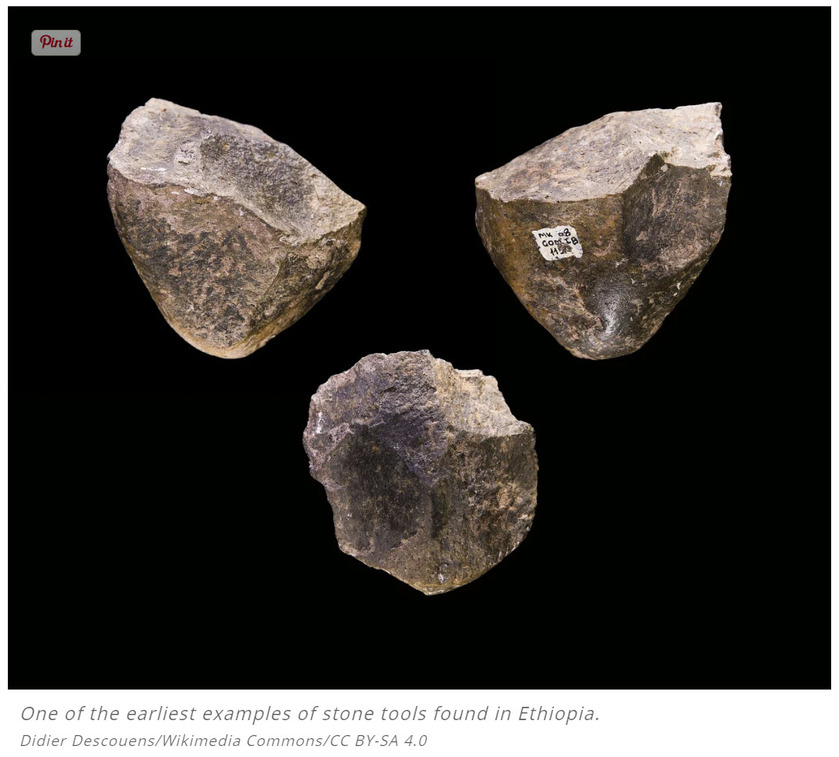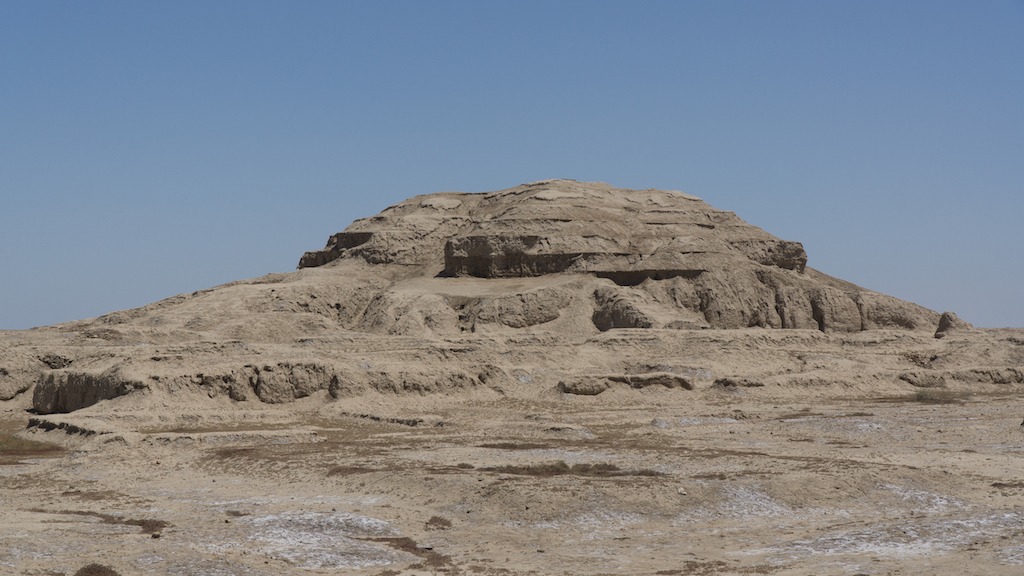Ever wondered what was mankind's first tool that started us using technology? Well the following from www.history.com and written by Sarah Puritt gives some us some insight.
"From sharpened rocks to polished stone axes, Stone Age human ancestors made progressively more complex devices over 2.6 million years.
Humans weren’t the first to make or use stone tools. That honor appears to belong to the ancient species that lived on the shores of Lake Turkana, in Kenya, some 3.3 million years ago. First discovered in 2011, these more primitive tools were created some 700,000 years before the earliest members of the Homo genus emerged.
The earliest known human-made stone tools date back around 2.6 million years. Crafted and used by Homo habilis (sometimes known as “handy man”), these implements marked the first in a series of major toolmaking advances among early human hunter-gatherer societies, lasting from the early Stone Age all the way up until the first modern humans, Homo sapiens, made the transition to permanent agricultural settlements around 10,000 years ago.
1.) Sharpened stones (Oldowan tools): 2.6 million years ago
The early Stone Age (also known as the Lower Paleolithic) saw the development of the first stone tools by Homo habilis, one of the earliest members of the human family. These were basically stone cores with flakes removed from them to create a sharpened edge that could be used for cutting, chopping or scraping.
Though they were first discovered at (and named for) Olduvai Gorge near Lake Victoria, Tanzania, the oldest known Oldowan tools were found in Gona, Ethiopia, and date back to about 2.6 million years ago. Oldowan tools represent the first “mode” in the framework of tool technologies proposed by the British archaeologist Grahame Clark in his book World Prehistory: A New Synthesis (1969), which is still used by many archaeologists for classification today.
2.) Stone handaxe (Acheulean tools): 1.6 million years ago
The next leap forward in tool technology occurred when early humans began striking flakes off longer rock cores to shape them into thinner, less rounded implements, including a new kind of tool called a handaxe. With two curved, flaked surfaces forming the cutting edge (a technique known as bifacial working), these more sophisticated Acheulean tools proved sharper and more effective.
Named for St. Acheul on the Somme River in France, where the first tools from this tradition were found in the mid-19th century, Acheulean tools spread from Africa over much of the world with the migration of Homo erectus, a closer relative to modern humans. They have been found at sites as far afield as southern Africa, northern Europe and the Indian subcontinent.
3.) A new kind of knapping (Levallois technique): 400,000 to 200,000 years ago
Though teardrop-shaped Acheulean handaxes remained the dominant tool technology until around 100,000 years ago, at least one significant innovation emerged long before that among early human species such as Homo neanderthalensis, or Neanderthals.
Known as the Levallois, or prepared-core technique, it involved striking pieces off a stone core to produce a tortoise-shell like shape, then carefully striking the core again in such a way that a single large, sharp flake can be broken off. The method could produce numerous knife-like tools of predictable size and shape, a considerable advance in toolmaking technology.
Named for the site outside Paris where archaeologists first recognized and described it in the 1860s, the Levallois technique was widely used in the Mousterian tool culture associated with Neanderthals in Europe, Asia and Africa as late as 40,000 years ago. While Neanderthals were long assumed to be far more primitive than modern humans, their prolific production of such relatively sophisticated tools suggests a more complicated reality.
4.) Cutting blades (Aurignacian industry): 80,000 to 40,000 years ago
This Upper Paleolithic stone tool tradition emerged among both Neanderthals and the first modern humans, or Homo sapiens, in Europe and parts of Africa. The central innovation of this type of toolmaking involved detaching long rectangular flakes from a stone core to form blades, which proved more effective at cutting. The blades’ shape also made them easier to attach to a handle, which gave greater leverage and increased efficiency.
Named for the French village of Aurignac, where prehistoric remains were discovered in a cave in 1860, the Aurignacian culture is associated with the first anatomically modern humans in Europe. In addition to their innovations with tools, the Aurignacians also made some of the earliest representational artwork, leaving behind engraved limestone tablets and blocks featuring depictions of animals such as aurochs, an ancestor of wild cattle.
5.) Small, sharp micro blades (Magdalenian culture): 11,000 to 17,000 years ago
The Magdalenian culture is a central example of the fifth and final mode in Clark’s framework of stone tool development, characterized by small tools known as geometric microliths, or stone blades or flakes that have been shaped into triangles, crescents and other geometric forms. When attached to handles made of bone or antler, these could easily be used as projectile weapons, as well as for woodworking and food preparation purposes.
The first microlithic technologies emerged among early humans in Africa and Eurasia about 50,000 years ago, during a time of rapid change and development that some anthropologists have called the “Great Leap Forward.” As the archaeologist John J. Shea wrote in an article in American Scientist in 2011, it was also a time when the climate varied dramatically, and humans may have needed more versatile and easily transportable tools as they migrated in search of readily available food sources in an unpredictable environment.
6.) Axes, celts, chisels (Neolithic tools): around 12,000 years ago
Starting around 10,000 B.C., during the Neolithic Period, otherwise known as the New Stone Age, humans made the transition from small, nomadic groups of hunter-gatherers to larger agricultural settlements. In terms of tools, this period saw the emergence of stone tools that were produced not by flaking but by grinding and polishing stones. These tools, including axes, adzes, celts, chisels and gouges, were not only more pleasing to look at; they were also more efficient to use and easier to sharpen when they became dull.
Polished Neolithic axes, like those found at sites in Denmark and England, allowed humans to clear wide swathes of woodland to create their agricultural settlements. Toward the end of the Neolithic Period, however, the emergence of copper and later bronze led humans to transition into using metal, rather than stone, as the primary material for their tools and weapons. The Stone Age had come to an end, and a new era of human civilization had begun. "
At that time these tools are like our own to us today. They advanced mankind to invent more and more tools and technology to bring us to where we are today. It is always interesting to look back to see where we came from and how technology has changed us.
Reference: https://www.history.com/news/hunter-gatherer-tools-breakthroughs
I have lost a lot of faith with the Medical Community and the Governments over the last several years, but there are a few good things that can raise above the corruption and the pushing of drugs a new approach to heal people. The following is from www.gaia.com and written by Hunter Parsons that does not involve any drug or pushing an ineffective so called vaccine that the drug company is not held accountable in any way but they use sound! The use of sound can regrow bone tissue! Here is the story:
"The future of regenerative medicine could be found within sound healing by regrowing bone cells with sound waves.
The use of sound as a healing modality has an ancient tradition all over the world. The ancient Greeks used sound to cure mental disorders; Australian Aborigines reportedly use the didgeridoo to heal; and Tibetan or Himalayan singing bowls were, and still are, used for spiritual healing ceremonies.
Recently, a study showed an hour-long sound bowl meditation reduced anger, fatigue, anxiety, and ...
Not a fan of a Defense Agency studying Anti-Gravity and other Exotic Tech, but if the commercial world and make this technology cheap that will change our world yet again. The following is about three minute read and from www.gaia.com. The below was written by Hunter Parsons:
"Wormholes, invisibility cloaks, and anti-gravity — it’s not science fiction, it’s just some of the exotic things the U.S. government has been researching.
A massive document dump by the Defense Intelligence Agency shows some of the wild research projects the United States government was, at least, funding through the Advanced Aerospace Threat Identification Program known as AATIP.
And another lesser-known entity called the Advanced Aerospace Weapons System Application Program or AAWSAP
The Defense Intelligence Agency has recently released a large number of documents to different news outlets and individuals who have filed Freedom of Information Act requests.
Of particular interest are some 1,600 pages released to Vice News, which ...
As our technology gets better we are discovering more about the history of mankind and pushing the timeline back further and further. The following article is from www.gaia.com and written by Michael Chary that discusses this new find that changes the historical timeline:
"Over the past decade, there have been a number of archeological revelations pushing back the timeline of human evolution and our ancient ancestors’ various diasporas. Initially, these discoveries elicit some resistance as archeologists bemoan the daunting prospect of rewriting the history books, though once enough evidence is presented to established institutions, a new chronology becomes accepted.
But this really only pertains to the era of human development that predates civilization — the epochs of our past in which we were merely hunter-gatherers and nomads roaming the savannahs. Try challenging the consensus timeline of human civilization and it’s likely you’ll be met with derision and rigidity.
Conversely, someone of an alternative...
Not sure if you have heard of a show on YouTube called "The Why Files". If not you should check it out it is interesting and has some humor with it on different subjects. Last weeks was on a different theory how the Universe works and how main stream Science is attempting to shut it down like is always seems to do if it goes aguest some special interest. Today it is akin to what happened to those who questioned the Earth was the Center of the Universe that main stream so called Science all believed during the Renaissance period, They called any theory that the Earth was not the Center of the Universe misinformation. Does this sound familiar today? People laughed and mocked people like Leonardo da Vinci, Nicolaus Copernicus, Georg Purbach as crack-pots, conspiracy theorists, nut-jobs and they were suppressed and even imprisoned for their radical thoughts and observations. Again it sounds like today in so many ways. In any event this is a good one to ponder and see even if a bad idea ...
Seemingly chaotic systems like the weather and the financial markets are governed by the laws of chaos theory.
We all have heard about chaos theory, but if you have not or have forgotten what chaos theory is well here you go from interestingengineering.com:
"Chaos theory deals with dynamic systems, which are highly sensitive to initial conditions, making it almost impossible to track the resulting unpredictable behavior. Chaos theory seeks to find patterns in systems that appear random, such as weather, fluid turbulence, and the stock market.
Since the smallest of changes can lead to vastly different outcomes, the long-term behavior of chaotic systems is difficult to predict despite their inherently deterministic nature.
As Edward Lorenz, who first proposed what became commonly known as the Butterfly Effect, eloquently said, "Chaos: When the present determines the future, but the approximate present does not approximately determine the future.""
You may have heard the term about chaos theory as a butterfly flaps its wings in Brazil,...
I for one have lost trust in Medical Doctors due to COVID and reflection that they seem to push pills for everything and untested so called vaccines that is using a unproven technology because the Government and the Medical Boards of the State told them to. There are a very few exceptions. Thus they do not address the key problem just prescribe more and more pills to keep you alive an sick longer for them and Big Phama to profit from you. Will AI do any better? Well that depends on what was used for the training of AI. If it also pushes pills and vaccines without question then you have the same problems noted above. However, if the AI Training includes all possible forms of treatment and they zero in on the right issues for the true problem then there is possibilities they would be way better than most of the current Medical Doctors today.
The following is from an article from interestingengineering.com and written by Paul Ratner:
"A new study looks at how accurately AI can diagnose patients. We interview the researcher, who weighs in on AI's role ...




























